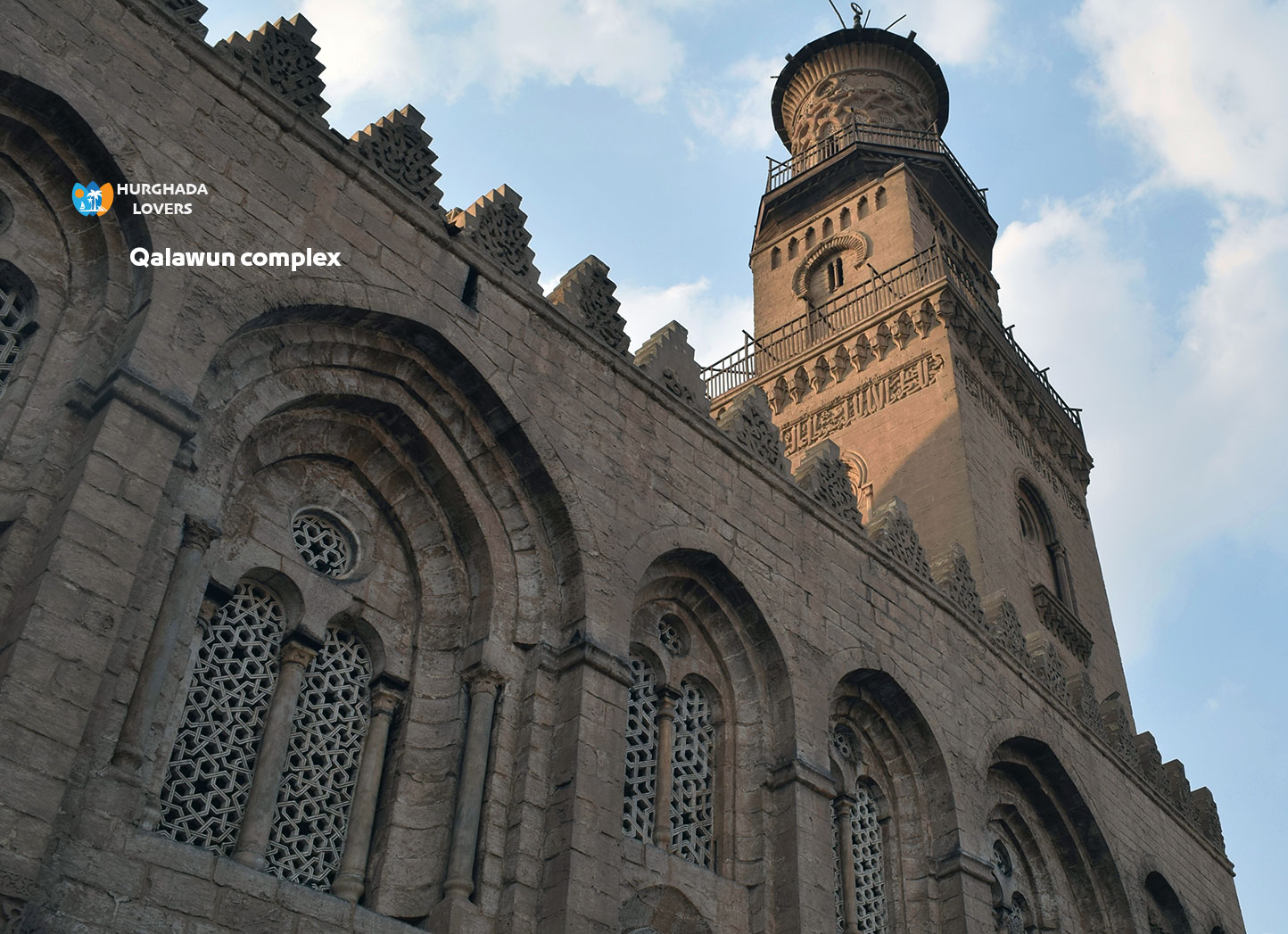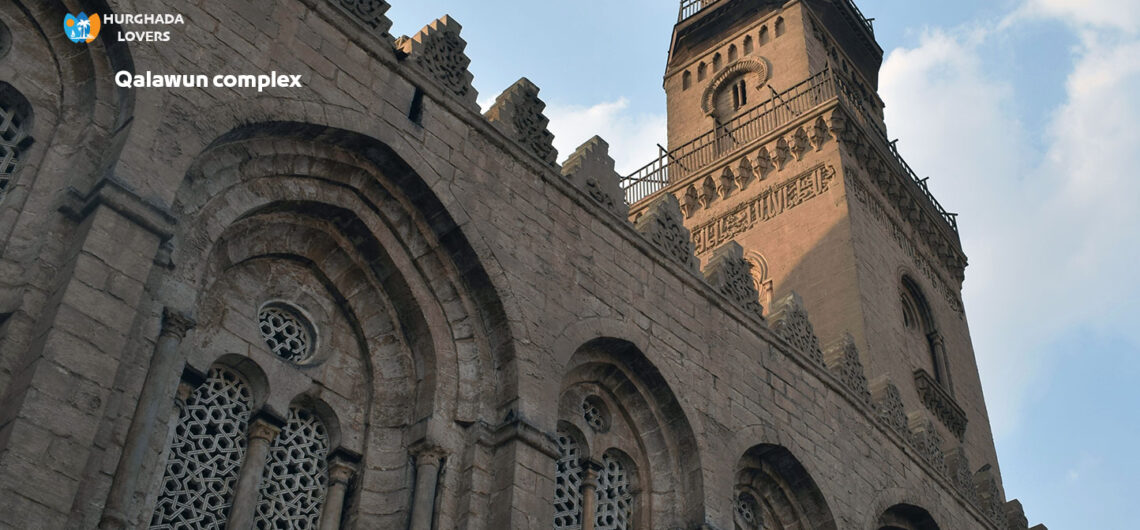Qalawun complex in Al Muizz street in Cairo, Egypt
Discover the facts and Islamic Egypt History to establish a mosque, a school, a dome, a mausoleum and a hospital of Al-Mansur Qalawun from the Mamluk era to rule Egypt and more about the most important Islamic Egypt Archaeological Sites.
Qalawun complex Facts
Or the mosque, school and dome of the hospital of Al-Mansur Qalawun in Al-Muizz Street, Cairo, Egypt. The history of the construction of the mausoleum, the minaret and the school and the historical aspect of the most important Egyptian Islamic and Islamic Egyptian Antiquities .
Sultan Al-Mansur Saif al-Din Qalawun built a group of buildings in the year 684 AH, corresponding to 1285 AD, in the Circassian Mamluk style, which includes a mosque and a school, in addition to a shrine and a hospital..
You will find the Sultan Qalawun complex overlooking Al-Muizz Street directly with a distinctive memorial facade and entrance, while you will find the hospital inside the complex, which was used to treat patients from the Egyptian people and the Mamluks..
You will see the facade of the tomb of Sultan Qalawun divided into arched cavities from below the windows with grilles topped by sunshades, in addition to a strip written in Thuluth script for the foundation and date of the construction of the mosque and the name of Sultan Qalawun..
The facade of the school is distinguished by being divided into 5 arched cavities, with a window with grilles at the bottom, then a parasol, then a lamp. You will also see the founding text on the facade of the shrine, in addition to balconies decorated with Islamic plaster decorations in the mold style..
The group includes a fountain on the facade of the school in the Hijab style, which had a dome resting on an octagonal neck with columns of tiles made of straw. It is called “Aqush Fountain”, and was built by Sultan Al-Nasir Muhammad bin Qalawun..
Above the entrance opening you will see a threshold on which the founding text is written, in addition to the passage between the school and the shrine (a square shape with an area of 21 by 22 meters with 4 columns in the middle and 4 supports), where the entrance leads to a hall (4 meters wide, 35 meters long, and 10 meters high).).
The vestibule was designed with a ceiling of wooden beams and star-shaped decorated panels, in addition to the presence of 6 doors in the chest, two of which lead to the hospital, two to the shrine, and two directly to the school..
On the walls of the mausoleum you will see the titles of Sultan Al-Mansur Qalawun on wooden panels in the shape of an octagon, in distinctive colors, plated with gold, and Islamic decorations in the Mamluk style..
You will find the mihrab in the middle of the southeastern wall of the mosque, where it is a cavity with a single arch of fake forged cymbals and decorated with 3 khornaqat and marble mosaic strips and a warrior’s cap covered with colors and marble mosaics as well..
In the middle of the shrine you will find a marble structure with a wooden coffin on it with Kufic and Naskh script written on it, as Sultan Al-Mansur Qalawun and his son Al-Nasir Muhammad were buried in the shrine..
You will find a 3-storey minaret, where the first and second floors are designed in a square shape and the third floor is in a skewed cylindrical shape and then a non-polygonal top. It was built during the reign of Sultan Al-Nasir Muhammad bin Qalawun..
You will find carved engravings and decorations on the wooden entrance door, with interest in knowing the collection of Sultan Al-Mansur Qalawun..
Al-Nasir Muhammad Ibn Qalawun Mosque
The mosque was built in 735 AH. You will find it directly after the middle gate among the mosques of the Citadel of Saladin al-Ayyubi “Salah Al-Din Al-Ayyubi“. King al-Nasir Muhammad bin Qalawun, the “Bahraini Mamluk State,” built the mosque, the most famous Historical mosques.
His era witnessed the most prosperous era of the Mamluks in ruling Egypt, as he ruled Egypt in 693 AH and died in 741 AH..
King Al-Nasir Muhammad bin Qalawun loved architecture, especially the influence of Persian and Andalusian art. He developed and restored many monuments and built mosques, schools and palaces during his rule of Egypt..
The mosque is distinguished by a mihrab with arches and a marble cladding inlaid with mother-of-pearl, in addition to colored ceilings and gilded tiles. In addition to a dome covered with green Qashani, which is why it was called the Green Minaret or the Green Dome..
The Mosque of Al-Nasir Muhammad ibn Qalawun was designed in the form of 4 canopies around an open courtyard, in addition to upper windows that include a group of plaster windows with unique decorations and colors..
Sultan Qaitbay repaired the Al-Nasir Muhammad ibn Qalawun Mosque, rebuilt its dome, and built a marble pulpit in 893 AH after the mosque had been vandalized and neglected following the death of King Al-Nasir Muhammad ibn Qalawun..
The Egyptian government and the Antiquities Committee of the Egyptian Ministry of Tourism and Antiquities were interested in repairing the dome and the rest of its sanctuaries, in addition to restoring it again with the same quality, drawings and Islamic decorations that were present..
Note: Facts and secrets of the history will be added soon…
Hurghada Excursions Lovers, Best Travel Agency in Hurghada to provide daily tours to visit the Tourist attractions of Luxor by Hurghada to Luxor Tours and Hurghada to Pyramids Trips. Book online when you come to Hurghada, El Gouna, Sahl Hashish, Makadi Bay, Soma Bay.

